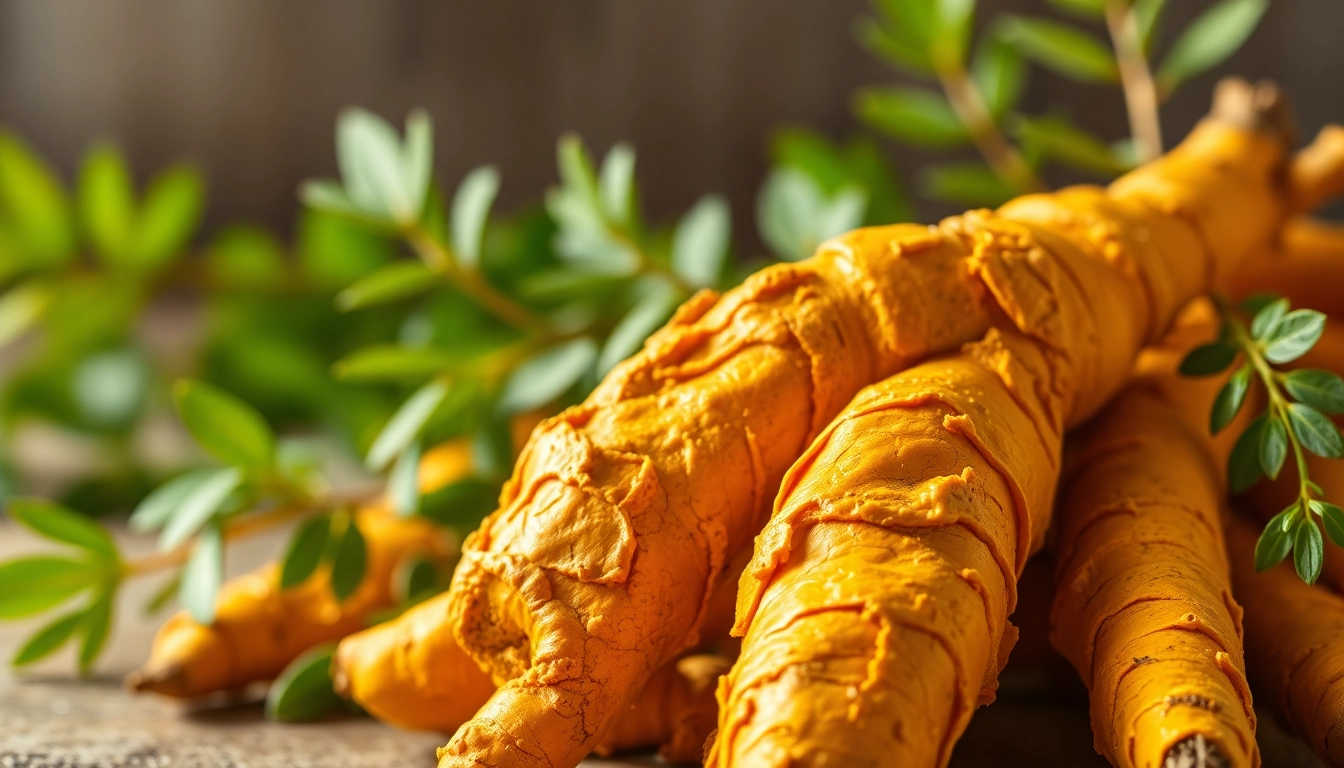Understanding Turmeric Root
What is Turmeric Root?
Turmeric root, scientifically known as Curcuma longa, is a flowering plant belonging to the ginger family. Its rhizomes, which are the underground stems, are harvested and extensively used in cooking and traditional medicine. Turmeric’s vibrant yellow-orange color comes from curcumin, the active compound known for its bitter flavor and numerous health benefits. Historically, turmeric has been utilized for thousands of years across various cultures, particularly in India and China, where it is a staple in many culinary and medicinal practices. As a relative of ginger, turmeric carries a pungent aroma and a unique flavor that enhances numerous dishes, from curries to teas. For those looking to explore the myriad ways to incorporate this healthful spice into their diet, turmeric root offers both culinary versatility and wellness potential.
Culinary Uses of Turmeric Root
Turmeric root is celebrated for its distinctive flavor and is an essential ingredient in many cuisines around the world, particularly in South Asian and Middle Eastern dishes. It can be used fresh, dried, or ground into powder, allowing cooks to adapt it across various culinary techniques. Here are some popular uses for turmeric root:
- Curry Dishes: Turmeric is a key component in many curry powders and is used with other spices to create richly flavored dishes.
- Teas and Beverages: Turmeric root can be sliced and steeped to make soothing teas. Golden milk—a mixtures of turmeric with milk and spices—has gained popularity as a healthful beverage.
- Marinades and Dressings: Its robust flavor pairs beautifully with vinegar, oil, and other ingredients in marinades and dressings, enhancing the taste of meats and vegetables.
- Smoothies: For those looking to enhance their morning drinks, turmeric root can be blended into smoothies for an additional nutritional boost.
Nutritional Profile of Turmeric Root
The nutritional profile of turmeric root is quite impressive. Here’s a deeper look at its key constituents:
- Curcumin: This bioactive compound is the star component of turmeric, known for its anti-inflammatory and antioxidant properties.
- Vitamins and Minerals: Turmeric contains essential vitamins, including Vitamin B6, Vitamin C, and minerals such as iron and manganese.
- Fiber: The root is a good source of dietary fiber, aiding in digestive health and regularity.
- Antioxidants: Apart from curcumin, turmeric contains other antioxidants that help combat oxidative stress in the body.
Health Benefits of Turmeric Root
Anti-inflammatory Properties
One of the most well-researched benefits of turmeric root is its potent anti-inflammatory properties, largely attributed to curcumin. Chronic inflammation is linked to various health issues, including heart disease, cancer, and neurodegenerative conditions. Numerous studies have shown that curcumin can suppress inflammatory pathways in the body, suggesting its potential as a natural anti-inflammatory agent.
Antioxidant Effects
Curcumin is also recognized for its ability to neutralize free radicals, which are unstable molecules that cause cellular damage. By increasing the body’s antioxidant capacity, turmeric root can help protect against oxidative stress and reduce the risk of chronic diseases. Research has demonstrated that curcumin can boost the activity of the body’s own antioxidant enzymes, thus enhancing overall health.
Potential Health Risks
While turmeric is generally safe for most people, it is important to be aware of potential side effects and interactions. High doses of turmeric or curcumin can lead to gastrointestinal issues, including nausea and diarrhea. Additionally, turmeric can interact with certain medications, especially blood thinners and drugs for diabetes. Therefore, it is advisable for individuals with underlying health conditions or those on medication to consult a healthcare provider before adding significant amounts of turmeric to their diet.
Incorporating Turmeric Root into Your Diet
Fresh vs. Dried Turmeric Root
Both fresh and dried turmeric have unique advantages. Fresh turmeric root is more vibrant in flavor and can be used directly in cooking. It is often preferred for teas and juices. Dried turmeric powder, on the other hand, is more concentrated in curcumin and provides a longer shelf life. When choosing between the two, consider the dish you are preparing: fresh works well in smoothies and stir-fries, while dried is ideal for curries and spices.
Recipes Featuring Turmeric Root
Incorporating turmeric into your meals can be simple and delicious. Here are a few creative recipes:
- Turmeric Ginger Tea: Boil freshly sliced turmeric and ginger in water. Add honey and lemon for flavor.
- Golden Milk Latte: Combine warm milk (or a milk substitute), turmeric, cinnamon, and a touch of honey in a blender for a creamy drink.
- Lentil Soup: Add chopped fresh turmeric to your favorite lentil soup recipe for an aromatic twist.
- Turmeric Cauliflower Rice: Grate cauliflower and sauté with turmeric, garlic, and olive oil for a nutritious side dish.
Doses and Recommendations
While there is no official recommended dose for turmeric, many studies suggest that 500-2000 mg of curcumin per day is beneficial for health. However, this can vary based on an individual’s health needs and preferences. It’s essential to incorporate turmeric gradually into your diet, starting with smaller amounts and observing how your body responds. Consider mixing turmeric with black pepper, which enhances the absorption of curcumin significantly.
Turmeric Root and Traditional Medicine
Use in Ayurvedic Practices
In Ayurveda, a traditional Indian system of medicine, turmeric has been used for thousands of years. It is considered a purifying herb, balancing the three doshas: Vata, Pitta, and Kapha. Ayurvedic practitioners often use turmeric to treat various ailments, including digestive issues, skin conditions, and respiratory problems. Turmeric’s anti-inflammatory properties are also valued in managing chronic conditions such as arthritis.
Turmeric in Herbal Remedies
Beyond its culinary applications, turmeric is a common ingredient in many herbal remedies. It is often combined with other herbs to create potent formulations aimed at enhancing health and vitality. Herbalists may use turmeric to support liver health, improve digestion, and boost immunity, thanks to its broad spectrum of benefits.
Scientific Studies on Turmeric Root
Numerous scientific studies have been conducted to explore the medicinal properties of turmeric and curcumin. Research has supported its role in alleviating symptoms of arthritis, reducing inflammation, and even diminishing the risk of certain cancers. Additionally, studies suggest that curcumin may have applications in neurodegenerative diseases like Alzheimer’s, showcasing its promise as a natural therapeutic agent.
Where to Buy Turmeric Root
Choosing Quality Turmeric Root
When buying turmeric root, whether fresh or dried, quality is key. Look for roots that are firm and vibrant in color, and avoid those that appear dull or are shriveled. For dried turmeric powder, opt for organic varieties whenever possible, as they often contain higher levels of curcumin and fewer additives. Reading labels can also help ensure that you are purchasing pure turmeric without unnecessary fillers.
Online vs. Local Markets
You can find turmeric root at local grocery stores, health food shops, and farmer’s markets. However, for specific varieties like organic or specialty turmeric, online retailers may offer a broader selection. Comparing prices and reading reviews can ensure you make an informed purchase, regardless of where you buy.
Popular Brands of Turmeric Root
Some reputable brands known for their high-quality turmeric products include Simply Organic, Frontier Co-op, and Fijian Spice. These brands typically prioritize organic sourcing and sustainable practices, making them excellent choices for those seeking to incorporate turmeric into their diets. Additionally, always check for certifications such as USDA Organic to guarantee quality.



